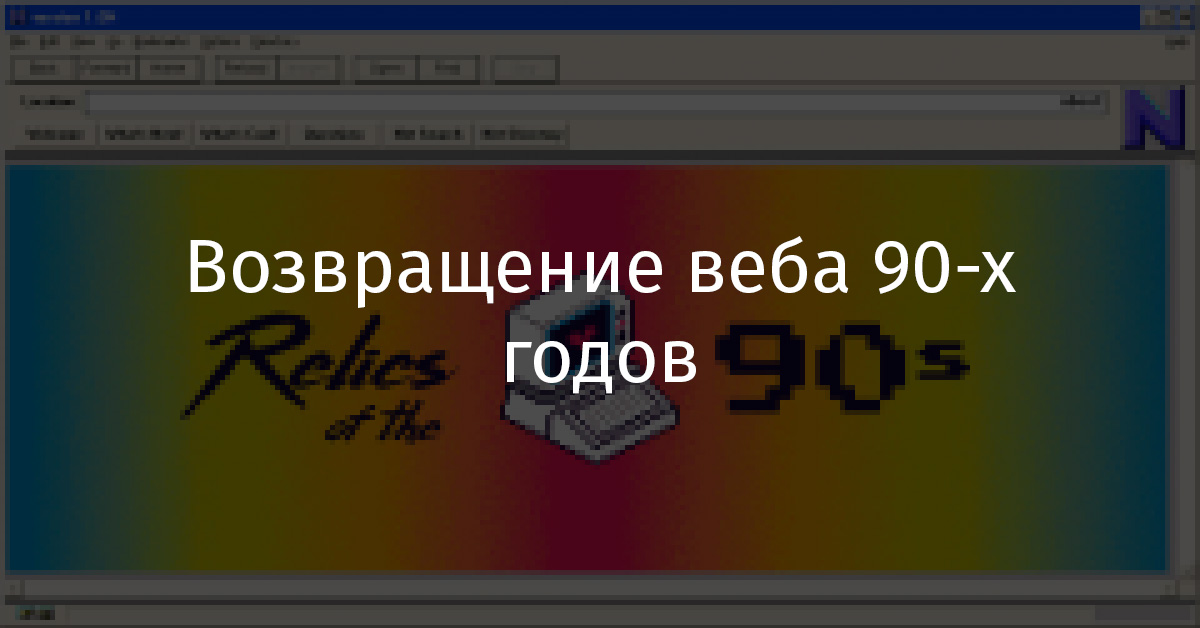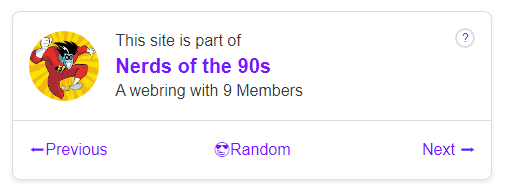When I look at some of the current trends on the web, I think that perhaps the cyclical nature is also present here. I wonder if we are ready to embrace the ideas of the early web again. Perhaps it is worth clarifying that I'm not talking about design here. I'm afraid the dancing-baby phenomenon is gone forever. Rather, I mean broader ideas from the past that have recently found a second life. And by the way, I like it.

Server rendering
After having spent the best part of the last decade moving the logic for rendering web pages to client systems, it feels like the pendulum is about to swing in the direction of server rendering.
With projects like Phoenix LiveView emerging and the " it's just HTML " approach of hey.com , it seems like Server-Side rendering (SSR) is returning to the spotlight.
It makes sense. The thing is, servers are very good at solving such problems. And sending compressed HTML over the network can be incredibly fast. The classic request-response cycle has also evolved. HTTP / 2 and smart techniques like Turbolinksand just-in-time pre-downloads make browsing the Internet much more enjoyable these days than when someone first tried to download a photo of Michael Jordan from the Space Jam website via a dial-up connection.
If the next generation of web applications removes the responsibility for rendering the interface and executing huge amounts of JavaScript code from users, it can be called a wonderful old new strategy for developing web projects.
Website development without writing code
FrontPage and Dreamweaver were popular in the 90s due to their implementation of what you see is what you get (WYSIWYG) approach. People could build websites without any programming skills. All the work consisted of dragging fields across the pages and entering text into those fields.
Of course, those who started working on sites in this way soon learned that the pages are based on program code that is simply not visible to those who do not know where to look. More often than not, this code was a mountain of automatically generated garbage. This approach ultimately prevented the appropriate tools from keeping pace with the evolving requirements of the modern web.

Webflow Platform
Today we have a better understanding of the web. The same can be said for our instruments. For example, Webflow is one of the contenders for the title of "no-coding visual editor for website development." The code that this platform generates looks much better than the one that could be seen in the 90s.
Tools like these probably won't replace real developers. It still requires a huge amount of human effort to create complex projects. But for the development of landing pages and marketing sites, such tools can become the "Holy Grail of WYSIWYG", which we thought remained in the 90s.
Personal sites
My commitment to IndieWeb may lead me to this idea, but I believe there is a renewed interest in personal websites now. Many social media giants are falling out of favor with internet users. People are again fascinated by the idea of owning a slice of the web rather than being one of a billion "usernames".
Our digital identities are becoming more and more important, and people are realizing that they are not in control of their data. Personal sites were very popular before MySpace and Facebook, and these days, creating such sites has never been easier.
Services like Carrd offer a convenient and straightforward way to create simple one-page pages. The statistics of such services indicate that people are very interested in them.
Blogging is gaining popularity again. Blogs are used as a means of personal marketing, or simply as platforms for expressing opinions. There are tons of tools out there these days for those looking to blog. The blog can be designed as your own site. You can use a specialized platform like micro.blog , which gives users a lot more freedom than Medium and Company.
Human Generated Lists
Another problem that social media has created is that the internet is now flooded with automatically generated article and news lists. We decided that the flow of materials in front of our eyes should never dry up. This has led us to create complex systems that select new publications for us based on our interests.
But these systems are essentially huge black boxes. No one really knows what is going on in their bowels. If you add ads, "fake news" and a couple of internet trolls here, we get the mess that all of us are familiar with.
That is why people strive to manage what they read based on their own preferences. These can be chronological collections of materials, materials selected by other people, materials grouped by a topic. We are talking about something like a selection of articles from reliable sources, created for a specific person.
One way to create such feeds is to use good old RSS technology. This is one of those boring technologies that was called dead, but the popularity of which again took off.
Here's a tweet about it. “Who will read your personal blog because it has an RSS feed?” - asks the author of the tweet. And he answers to himself: "I will read."
Another possibility of finding quality content is to select materials based on the recommendations of other people, not algorithms. People whom we already know from some high-quality materials recommend other people publications on similar topics. Such activities lead to the creation of decentralized clusters of information that can be trusted.
Website owners often did this in the days before there were search engines. They maintained lists of links to other blogs or created web rings of similar sites.

Web Ring Widget Web
rings were a common way of linking sites together on the early web. In order to become a member of the web ring, it was necessary to embed a small widget on the site containing buttons like "Forward", "Back" and "Random site". Clicking on these buttons led the site visitors to other sites on the web ring to which they belonged. By the way, if you want to host your own web ring, I have something for you.
Small communities and web monetization
Many content creators are leaving the big platforms that “absolutely everyone is sitting on” to more closed, niche communities. New membership models on sites like ghost.org allow content creators to build communities around what they do. People teach other people something, self-publish books, or give others access to APIs to solve specific problems.
In the 90s there were chat rooms and message boards. We now have platforms such as Discord and Twitch at our service to help people with common interests find each other. These highly specialized communities can serve as a solid user base for independent businessmen.
Of course, the problem of monetization has been around since the beginning of the web, and it's not easy to make money these days without putting up ads all over the place. But new standards like the Web Monetization API could be a very interesting solution to the monetization problem, allowing content creators to receive micropayments for what they create.
Drawing lessons from past experiences
I don't know if the above trends will intensify or if we will see something completely different on the web. But I am quite confident that learning from past experience is good. It is thanks to this that the world is moving forward.
Therefore, perhaps the "second 90s" will be even better than the "first". At least this time we have already resolved the issue with NSYNC.
What technologies of the early web do you think might well be reborn in our time?
